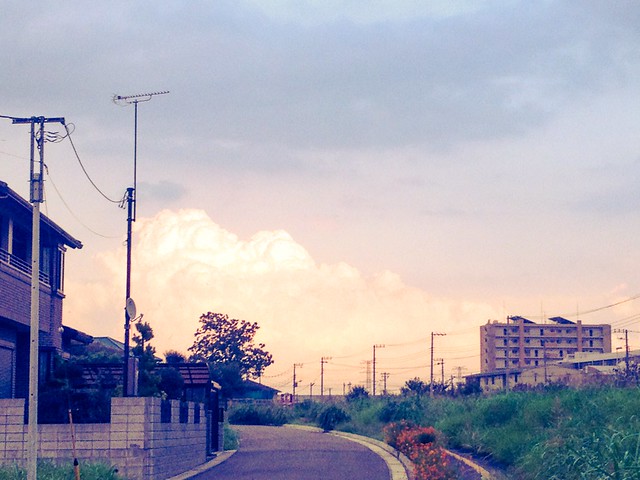
Clouds roil in the
Distance; Perhaps o'er there they
Reign for now not here.
If you ask any Japanese person to imagine themselves in a casually conceived summer landscape, you would find yourself with a fairly long list of staples, from glass 風鈴 (ふうりん, wind chimes) to sparkly 花火 (はなび, hanabi), and snowy かき氷 (かきごおり, shaved ice) to, apparently, curry. Especially if it's done while wearing a 浴衣 (ゆかた, yukata).
If you ask me to conjure an image of a Japanese summer, you'd get a man drowning in his own sweat, being eaten alive by millions and millions of tiger-mosquitos.
Whose is a more accurate representation of the true spirit of a Japanese summer, maybe no one will ever really know.
Except that I do know that the domestic (non-industrial) pesticide market in Japan (蚊遣器) is a 4.23 BILL¥$s-a-year industry
1This should be read as "Bill-yen-dollars-a-year," not "Billys's."
1. That's BILL¥$s with a capital-BILL. If this number seems outrageously high, it's probably because I made it up. I don't know the right kanji to use to search for the real numbers on Google. Or Yahoo!. Or whatever terrible search engine the Japanese people use nowadays. Maybe AltaVista.Regardless, insecticides like 蚊取り線香 (かとりせんこう, katori-senkou) have been a Japanese summer-time tradition for millennia. As long as the Japanese have been burning incense, living things have inhaled said incense and died. And, so no image of summer in Japan would be complete if lacking the distinct paste-green (or cork-brown) coiled incense, wafting its fine, filament fingers through the moisture-laden air.
Not letting petty facts or statistics get in the way of a half-decent narrative, I think we'd all agree to include katori-senkou in our summer-collages. Whether it's the first or last thing we add is inconsequential: all that matters is that it's there. And it's almost always pictured hung, suspended in the body of a plain, ceramic housing molded to the shape of a stout, cartoon piglet: the蚊遣り豚 (かとりぶた, katori-buta), the mosquito-catching pig.
But why a ceramic pig? How is that any more "summer" or "insect-repelling" than, say, a cat, or a dog, or a tanuki, or Tommy Lee Jones?
Well, ask a simple question to a Japanese person and you get a simple Japanese answer: 「あぁ、そうなんだ。知らない。」
Yappari, "I don't know."
It has been written that Japan exists on many planes, the most important of which is the Floating World, the ephemeral world of art and inspiration, which has no ties to the messy discord of earth and yet from which man can neither ascend to heaven, but floats here and there and then disappears as the clouds go.
But, perhaps, Japan is more, as it is said in 風立ちぬ (The Wind Rises), Japan is the embodiment of Thomas Mann's Magic Mountain, "A place of forgetting." It is a wonderful world where, when you climb, the terrible past is left behind and forgotten. At the summit is fantastic play and creation and new life, unfettered, unburdened by, unbound to the world below. But to descend is to waken from the dream, a dream that is at once immaterial, inconsequential and just as soon, itself, forgotten. "Start a war in China, forget about it; start a puppet state in Manchuria, forget about it," it is said and then forgotten. And all that is remembered is how めんどくさい all that once was.
Maybe it's because pigs are immune to mosquitos, by lore, or maybe it's because they possess a great affinity for bugs and, in order for the incense to do its work, the mosquitos have to fly close to the senkou smoke. Then again, if it's like everything else in Japan, it's probably just a thing that happened to look like something and so it became a thing.
But in order to know what that "first thing" was, we had to go all the way to 三重県四日市市 (Yokkaichi City, Mie Prefecture).
Mie-Ken is in a part of Japan that is famous for producing high quality rice (and, by extension, sake)
2 But really, what place in Japan would claim otherwise?
2. And while Yokkaichi is not particularly known for any of its distilleries, it garnered great renown in the 19th century for the production of 蛮古焼 (ばんこやき, banko-yaki), a reliable, sturdy porcelain that could be used for tea ceremony implements or serve-ware and bottles for high-quality sake.Or, if left unfinished so the bottom of the bottle remains open, and then laid on its side, becomes an excellent, aerated receptacle for a suspended katori-senko. Add some feet to stabilize the bottle or a couple eyelet flags for hanging and you have yourself a handy little...
 | 4You don't even have to go to Mie Prefecture to see this, as this very katori-buta makes its home at the Shinjuku Historical Museum in Tokyo. Heck, I didn't even get THAT far… 4 |
...pig. Or what have you. What matters is that they all eventually become pigs. Even mine. And it's not even ceramic. Nor does it even use incense. But it's a pig, nonetheless. Even though it plugs into the wall.

O'er old roads new are
Laid and forgot but thought as
Only troublesome.